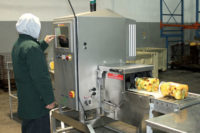Tech Update: Power Transmission Equipment - Increasing uptime in demanding environments

This application eliminates pulleys and belts by combining a Baldor/Reliance Super-E SS encapsulated motor with Baldor’s Dodge EZ Kleen Tigear-2 reducer. Source: Baldor Electric Company.

The Rexnord 2010 MatTop chain with sideguards and a scooped pusher attachment handles fruit snacks on an elevator conveyor. Source: Rexnord.

The four phases of maintenance maturity is a way of showing how processors deal with breakdowns. For processors in the “firefighting” stage that still want to be competitive, it’s time to move at least a couple of notches up to the “promoting” stage. Moving toward a world-class facility begins with understanding current behavior and defining objectives for the future. Source: SKF.

A “silent chain” uses a two-pin rolling pivot joint where its movement has no rolling friction. Source: Bosch Rexroth.




The key to long life and less energy usage is proper maintenance.
Surviving cleaning operations through good design
Stop putting out maintenance fires
Improper setup kills equipment
The weakest “link”
Looking for trouble
Four lessons learned from the field |
|
Speed reducers can take punishment from both process materials and washdowns. A large olive producer had tried various epoxy-coated speed reducers and found that they could not hold up to the acidic brine solutions and oils used on the processing lines at the plant. In addition, a caustic washdown environment also posed problems with the gearboxes. The plant installed Boston Gear stainless steel (SS) 700 Series speed reducers, which not only survived the acidic brine, but also survived the caustic washdown. The reducers are constructed from 316 SS and feature double-lipped shaft seals and a large, internal H1 food-grade oil reservoir.
In a North American brewery line application, Ian A. Rubin of Emerson Power Transmission found that excessive lubrication led to increased bearing operating temperatures, resulting in increased internal pressure that became strong enough to force the seal to pop out, and the chemicals used in the brewing process led to excessive corrosion in the bearing steel. Rubin recommended the brewery use Sealmaster reduced maintenance PN Gold mounted bearings because they don’t require additional lubrication, and the stainless steel housing with phosphorus nickel coated raceways help significantly reduce corrosion. While the old bearings lasted less than six months, the new bearings run for 18 months without failure, and the brewer is changing out 150 additional old bearings with the new ones.
Exposed power transmission system components—such as belts, chains, pulleys, friction brakes and sprockets—challenge machine builders to find ways of limiting surfaces for bacteria to grow. According to Stan Porter, vice president with Force Control Industries, an electric, open dry-fiction clutch brake, which had an attached high-maintenance cost and was part of a dairy processor’s cheese cutter, was replaced with a Posidyne Oil Shear Clutch brake, which allowed doubling the machine’s speed while eliminating adjustment, parts replacement and downtime. The brake is a totally enclosed, sealed unit.
A sugar producer was looking for a solution to low machine reliability that caused line stoppages during the main production season. During operation, the centrifuges suffered from acceleration/deceleration cycles, resulting in increased demands on the power transmission system, the motor and the centrifuge grouting system. SKF engineers performed a transmission assessment that identified a lack of rigidity in the motor support system. High vibration levels on the motor and misalignment of the pulleys caused excessive energy consumption. The engineering team recommended a new package of SKF belts using appropriate mounting practices to obtain correct alignment and belt tension. After the project was completed, there was an increase in machine reliability with no unexpected failures during the season. The belt, bearing and motor life increased, and the processor realized a 6.5 percent reduction in energy consumption, saving 24 MWh per year in the centrifuge motor.
|
Looking for a reprint of this article?
From high-res PDFs to custom plaques, order your copy today!










